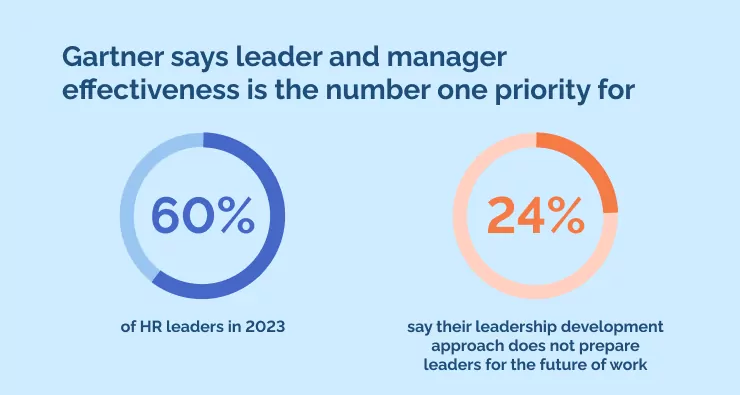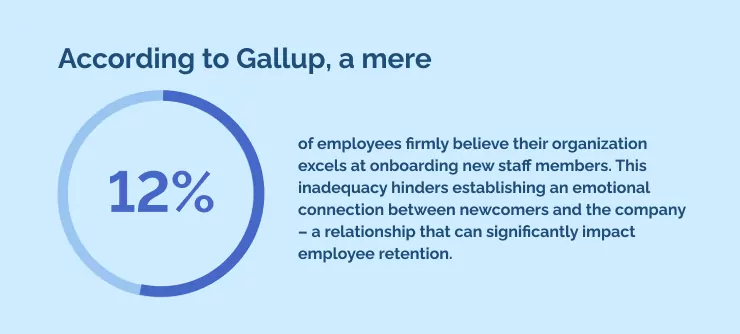
An HR strategy establishes a comprehensive overview of the entire employee lifecycle, from recruitment and selection to training and development, performance management, and talent retention.
With Forbes citing talent shortages, employee experience, and the need for a more purpose-driven workplace emerging as top HR trends for 2023, the benefits of a robust HR strategy that aligns human capital management with core business values become clear.
When executed effectively, a strategic HR plan bolsters workforce efficiency and fosters continuous organizational development by comprehensively supporting employee growth and satisfaction at every level.
As digital transformation continues to emanate across sectors, a well-crafted HR strategy becomes increasingly vital in facilitating the change management of such future-ready initiatives. By aligning human resource efforts with the evolving digital landscape, organizations can empower their workforce to adapt and thrive in the face of rapid technological advancements and industry disruptions.
Gartner says leader and manager effectiveness is the number one priority for 60% of HR leaders in 2023, and 24% say their leadership development approach does not prepare leaders for the future of work.

In this article, we’ll explore the importance of HR strategy and its role in transforming employee contentment into organizational success. We will discuss an HR strategy, its significance in attracting top talent and fostering a positive work environment, and the benefits of strategic HR planning, such as cost savings and increased productivity.
We’ll also provide a step-by-step guide on creating an effective HR strategy and best practices for successful implementation.
What is a HR strategy?
An HR strategy, or Human Resource strategy, is a comprehensive and well-structured plan that outlines an organization’s approach to managing its most valuable assets – its people.
This strategy serves as a roadmap for aligning human resource management practices with the broader business objectives, ensuring that the workforce effectively contributes to achieving the organization’s goals. Typically, HR strategies can be classified into two types: macro systems, which encompass the entirety of an organization’s people management processes, and micro strategies, which concentrate on specific aspects of talent development, employee engagement, and performance improvement within the company.
According to Gallup, a mere 12% of employees firmly believe their organization excels at onboarding new staff members. This inadequacy hinders establishing an emotional connection between newcomers and the company – a relationship that can significantly impact employee retention.

The Importance of an HR Strategy
The significance of an HR strategy cannot be overstated, as it plays a pivotal role in shaping an organization’s success and long-term sustainability.
Respondents to the McKinsey survey reaffirmed this sentiment, with 70 percent of US-based employees saying that their work defines their sense of purpose.

“Employees expect their jobs to bring a significant sense of purpose to their lives. Employers must help meet this need or be prepared to lose talent to companies that will.”
By aligning human resource management practices with overarching business objectives, an HR strategy creates a synergistic relationship between the workforce and the organization’s prospects.
One crucial aspect of an HR strategy’s importance lies in attracting and retaining top talent. A well-designed strategy ensures that organizations recruit individuals with the right skills, values, and cultural fit, contributing to increased productivity and innovation.
The importance of an HR strategy is multifaceted, encompassing talent acquisition and retention, employee development, organizational culture, and cost optimization. By developing and implementing a well-planned HR strategy, organizations can unlock the full potential of their workforce, paving the way for increased organizational speed.
The benefits of strategic HR planning

The benefits of strategic HR planning extend beyond the immediate concerns of human resource management, impacting overall organizational performance and growth. By adopting a forward-thinking approach to HR practices, companies can unlock the full potential of their workforce and create a thriving work environment. Key advantages of strategic HR planning include:
Talent Optimization:
- Attracting top talent with the right skills and cultural fit
- Reducing employee turnover through effective retention strategies
- Streamlining recruitment processes, saving time and resources
Employee Development:
- Enhancing workforce skills through targeted training and development programs
- Facilitating career progression opportunities for increased job satisfaction and loyalty
- Fostering a culture of continuous learning and improvement
Performance Management:
- Aligning individual performance with organizational goals
- Implementing objective assessment methods to evaluate employee contributions
- Encouraging a feedback-driven culture for continuous growth and development
Organizational Culture:
- Cultivating a positive and inclusive work environment
- Promoting diversity, equity, and inclusion to harness diverse perspectives
- Boosting employee engagement and satisfaction levels
Cost Efficiency:
- Optimizing resource allocation by streamlining HR processes
- Reducing operational costs associated with high turnover rates
- Ensuring compensation and benefits packages remain competitive and cost-effective
In summary, strategic HR planning offers many benefits, including talent optimization, employee development, performance management, organizational culture, and cost efficiency. Organizations can drive productivity, innovation, and long-term success by incorporating a well-designed HR strategy into their operations.
How to create a HR strategy

HR strategies are critical for organizations to succeed and achieve their goals.
Developing a well-crafted HR strategy requires multiple steps that involve a deep understanding of the organization’s objectives, employee skills, talent management approaches, and data-driven insights.
Undertaking a comprehensive SWOT analysis is the first step for most organisations when developing an effective HR strategy. By evaluating an organization’s Strengths, Weaknesses, Opportunities, and Threats, HR leaders gain insights into workforce dynamics. The analysis highlights inherent advantages and areas needing improvement, while considering the broader landscape in which the organization operates.
Identifying opportunities and potential threats enables HR professionals to capitalize on prospects, devise contingency plans, and mitigate risks. Conducting a SWOT analysis serves as a vital foundation for shaping a robust HR strategy, fostering a thriving workforce, and propelling the organization towards sustained growth.
Once a SWOT analysis has been conducted, HR leaders can move forward with crafting a tailored HR strategy. Here are 11 essential steps to create an effective HR strategy:
- Determine the organization’s goals and objectives – The first step in developing an HR strategy is determining the organization’s goals and objectives. This involves identifying the company’s mission, vision statements, and long-term goals and objectives. Setting clear goals and objectives makes it easier to create a direction and purpose for the HR strategies that will be implemented.
- Analyze employee competencies – Analyzing employee competencies is another critical aspect of developing an effective HR strategy. It involves assessing current employees’ skills, knowledge, and experience to determine their strengths and weaknesses. This information can then identify opportunities for upskilling, reskilling, and talent development.
- Perform a skills gap assessment – A skills gap assessment is another essential step in developing an HR strategy. It involves identifying the skills and competencies required by the organization to achieve its goals. By comparing these requirements with employees’ current skills, HR managers can identify gaps and develop targeted training and development programs to close those gaps.
- Establish a timeframe – Establishing a timeframe is also crucial for effective HR strategy development. This includes setting realistic timelines and deadlines for each initiative and tracking progress toward those goals.
- Examine talent management approaches – Examining talent management approaches is another critical step in developing an HR strategy. It involves creating strategies for recruitment, performance management, career development, and retention of top talent. This includes developing a comprehensive employee value proposition that aligns with the organization’s overall mission and vision.
- Enhance current employee abilities – Enhancing current employee abilities is an ongoing process that requires continuous learning and development opportunities. This includes providing access to training programs, mentorship, coaching, and feedback to help employees acquire new skills and knowledge to contribute to their personal growth and the organization’s success.
- Minimize staff turnover – Minimizing staff turnover is critical to maintaining a stable and productive workforce. HR strategies focusing on employee engagement, recognition, and retention can help reduce turnover rates and increase employee satisfaction.
- Collaborate with business executives and stakeholders – Collaborating with business executives, and stakeholders ensures that HR strategies align with broader organizational goals and objectives. This involves building strong relationships with key stakeholders and engaging them in developing and implementing HR strategies.
- Prepare for future succession – Preparing for future succession is critical to ensure continuity and success in the long term. This involves identifying key positions and developing plans to identify and develop internal talent to fill those roles.
- Utilize data-driven insights – Utilizing data-driven insights is essential to measure the effectiveness of HR strategies and make informed decisions. This includes using metrics and analytics to track progress, identify areas for improvement, and make data-driven decisions.
- Formulate a mission and vision statement – It provides a clear framework for HR strategies and aligns them with the organization’s overall mission and vision. This allows HR managers to create strategies that support the company’s values and culture and contribute to its overall success.
HR Strategy: What Next?
Creating a comprehensive HR strategy is only the first step toward building a thriving workforce. HR managers must also implement, monitor, and continuously improve their strategy to remain effective.
What comes after creating an HR strategy is equally as important as the strategy itself.
After creating an HR strategy, it’s essential to prioritize and execute initiatives in a timely and efficient manner. It involves aligning the HR strategy with the company’s broader goals and objectives to create a roadmap for implementation. This roadmap should include timelines, milestones, and clear deliverables, making it easier to track progress and identify areas for improvement.
HR managers should also continuously monitor and evaluate their strategies’ effectiveness. This involves measuring various aspects of digital adoption and analyzing data and metrics to gauge performance against predetermined goals and make necessary adjustments. Measuring success against quantifiable objectives such as employee retention rates, productivity, and engagement levels is crucial.
Another critical step in implementing and maintaining an effective HR strategy is ongoing communication and collaboration with other departments and stakeholders. HR managers must work closely with business executives and department heads to ensure the HR strategy aligns with the organization’s overall mission, vision, and culture. Collaboration with employees is crucial to meeting their needs and expectations, leading to higher engagement and job satisfaction.
Training and development programs are also critical to the success of any HR strategy. HR managers should invest in continuous learning opportunities, mentorship, coaching, and feedback sessions to help employees acquire new skills and knowledge to apply to their roles. This creates a more productive and engaged workforce, contributing to overall business success.
HR managers should also be flexible and adaptable to changing business needs and external environmental factors. The world of work is constantly evolving, and HR strategies must change accordingly. Regularly assessing and updating HR strategies is essential to ensure continued success.
Celebrating successes and addressing challenges is essential to maintain momentum and encourage further progress. Celebrating successes helps build morale while addressing challenges head-on, enabling HR managers to identify and address potential roadblocks before they become significant issues.
Creating an effective HR strategy is the first step toward success. Implementing, monitoring, and continuously improving HR strategies is critical to ensure continued success and a thriving workforce.
By prioritizing execution, monitoring performance, collaborating with stakeholders, investing in training and development, adapting to change, and celebrating successes, HR managers can build a more productive, engaged, and successful workforce.
Tristan Ovington
Tristan Ovington is a professional senior writer and journalist, specializing in providing expert insights on various topics such as digital adoption, digital transformation, change management, and Cloud apps. He delivers his knowledge through accessible online content that is data-driven and presented in a friendly tone, making it easy for readers to understand and implement.



